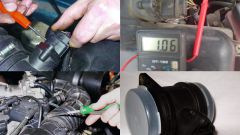You will need
- - vacuum gauge;
- - vacuum pump;
- - tester (voltmeter);
- - tachometer.
Instruction
1
To test the sensor analog type, first connect the adapter to the vacuum hose between the intake manifold and the sensor. Connect a vacuum gauge.
2
Start the engine and let it idle. If the vacuum in the manifold is not too high, i.e. not more than 520 mm Hg. article, check the vacuum hose for kinks and damage and the correct installation of the camshaft belt. The reason for this low dilution may also be a defect in the diaphragm of the sensor.
3
Disconnect the vacuum gauge and connect instead the vacuum pump. Create by means of the pump to the sensor vacuum around 555-560 mm Hg. the article Then stop pumping the vacuum pump. A working gauge will show vacuum at least 25-30 seconds.
4
To test the sensor of absolute pressure type, use digital tester by switching it to a voltage measurement.
5
Turn on the ignition. Find the power contacts and ground. Connect the positive terminal of the voltmeter to the wire, which is connected to the signal terminal of the sensor pressure. A working device will show the voltage to ground of about 2.5 V.
6
Switch the device mode of the tachometer. Disconnect the vacuum hose from the sensor pressure. The positive terminal of the measuring device connect to the signal wire, and connect the negative to the ground wire of the sensor pressure. Normally, the device will show 4400-4850 rpm.
7
Connect to the hose sensor vacuum pump. Change the vacuum in the sensor pump, observe the device being in the mode of the tachometer. A symptom of health is the stability of the dilution and the readings.
8
Disconnect the vacuum pump. The device is in the mode of tachometer should show from 4400 to 4900 rpm If these values are not maintained, replace the sensor that is operating correctly.

